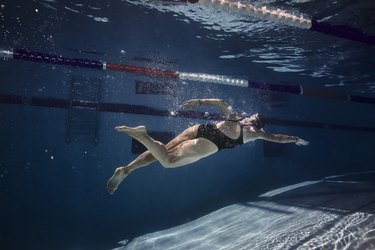
Swimming is a low-impact exercise that is easy on your joints, but if you use faulty stroke mechanics, you might find your neck sore after swimming. Because swimming depends so heavily on technique, any imperfections affect your speed and efficiency in the water.
When you swim harder to go faster, you can strain already taxed neck muscles, leading to pain and stiffness.
Video of the Day
Video of the Day
Read more: Causes of Pain in the Neck & Back of the Head
Neck Structures and Pain
In your neck area, seven bony vertebrae surround your spinal cord as it descends from your brain down toward your lower torso. Multiple nerve offshoots branch from the cervical spine to your arms and upper torso. The Mayo Clinic notes that any arthritic changes to your cervical vertebrae or compression on the nerves leaving the vertebrae in your neck can result in tingling numbness and pain anywhere in your upper body as well as in your neck area.
Preexisting injuries also might leave you stiff and sensitive in your neck area. Generally, swimming helps strengthen supporting muscles and alleviates pain from stiff, sore necks. When you feel worse after your workout than before, though, you should analyze your stroke technique.
Neck Sore After Swimming
Swimming the freestyle stroke might lead to neck pain if you do not keep your head aligned with your body. You ideally keep your head and your body in a straight line throughout the entire stroke. A proper, neutral head position leaves you looking at the bottom of the pool when you swim freestyle.
Looking slightly forward toward the end of the pool puts stress on your spinal column and neck muscles, leading to stiffness or pain. Keep your head aligned with your spine during the breaststroke too, particularly when you scull above the water.
Breathing Position and Timing
Beginning swimmers sometimes overcompensate when they breathe, lifting heads far out of the water. Raising your head too high, tucking it tightly against your shoulder or rotating your head too much not only causes stiffness and pain but also tingling and numbness.
Rotating your body during your freestyle stroke minimizes the need to lift or twist your neck, and breathing on both sides helps avoid strained neck muscles. The backstroke does not cause as many problems, because you do not need to move your head to breathe. For the butterfly stroke, focus on breathing early in your stroke, before your arms recover above the water.
Read more: Five Basic Skills in Swimming
Recovery From Neck Pain
When your neck aches after swimming, take time out from swimming your usual routine. Vary your workout by swimming a different stroke or do water jogging or running to keep your fitness levels up while you recover. Meet with a coach and discuss your neck problems. A few sessions spent improving your technique can reduce or eliminate any future neck pain or stiffness.
In addition, neck-strengthening exercises can help relieve neck pain caused by arthritic conditions, according to the Arthritis Foundation. Consult a physical therapist for an individualized exercise program.
See a Doctor
According to a 2014 article published by Medical Clinics, neck pain can be a sign of a serious condition called myelopathy. This condition develops when the area around your spinal cord narrows.
In addition to neck pain, you might experience numbness, difficulty walking, decreased fine motor skills, leg weakness and loss of bowel or bladder control. Hyperextension of the neck, which can occur in swimming, can make this condition worse. Consult your doctor for a diagnosis of the underlying cause of your neck pain.